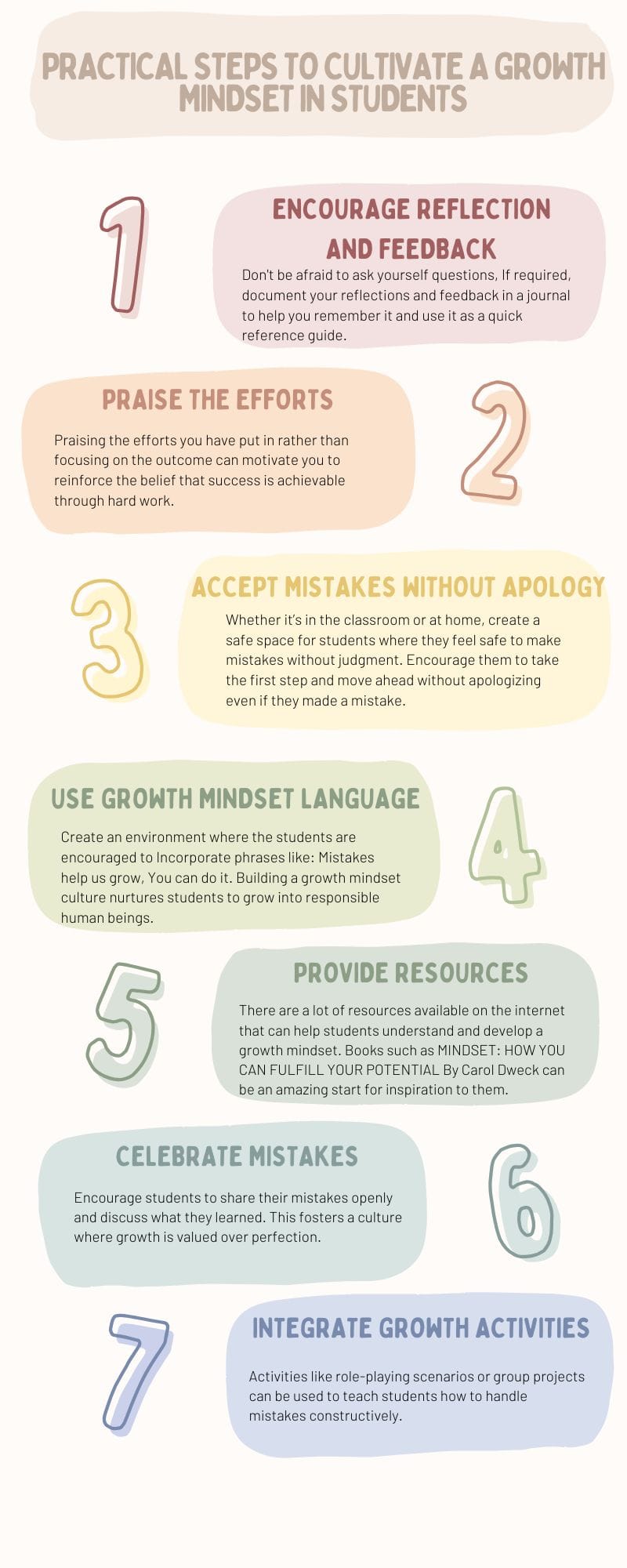Mistakes are crucial learnings of life, they are inevitable; but how do students with a growth mindset see their mistakes can shape their personal and academic growth? Understanding the power of a growth mindset can be transformative for students, especially those aiming for excellence. A growth mindset allows students to see their mistakes not as failures, but as opportunities to learn and grow.
Making mistakes is not a sin for which somebody should be punished, however, repeating those mistakes time and again impacts your development and growth negatively. In this article, we will explore how students with a growth mindset see their mistakes and how adopting a growth mindset can bring a change in your perspective and may significantly improve personal development, relationships, and well-being.

What Is a Growth Mindset?
Mindset in simple words refers to someone’s way of thinking. How someone reacts in a particular situation has a direct relation to the way they think. If you could know in advance about someone’s attitude, it would become much easier for you to understand how they might react or could react in a particular scenario.
Growth Mindset: People with a growth mindset consistently change their mentality with new ways of thinking. They continuously evolve their thinking through learning, developing, and enhancing their intelligence. They have a keen interest in seeing things from a different lens, and this is what keeps altering their perspectives.
How Do Students With a Growth Mindset See Their Mistakes?
1. Mistakes are Learning Opportunities
A growth mindset triggers the learning process and that’s why students with a growth mindset see mistakes as a critical part of the learning process. Instead of feeling ashamed or sorry, they strive to improve themselves and find answers to questions like:
- What went wrong?
- What can I do to improve?
which helps develop a reflective approach that uncovers gaps in their understanding and builds a positive mindset to address them effectively.
To develop this mindset, students can check out this highly rated self-reflection journal that can help them cultivate better learning habits and benefit from tools like guided journals or self-reflection workbooks.
2. They Encourage Feedback
Receiving constructive criticism can feel daunting, but for growth mindset-oriented students, feedback is seen as a gift, not criticism. They encourage people to reflect on their work and ask for genuine feedback in return. Instead of dwelling on the negativity, they rather focus on the actionable insights that can help them become better.
As a parent, teacher, or family member, providing proper feedback to the children is important. Pointing out mistakes and teaching children to take feedback constructively right from an early helps them develop a growth mindset. They need to realize that improving on mistakes is the stepping stone for the path ahead in life.
3. I Can Do This
A single word can shift perspectives. Instead of saying, “I can’t do this,” students with a growth mindset say, “I can do this”, maybe not today but someday it will happen. A growth mindset triggers such kind of attitudes in kids where they learn not to give up.
Mistakes are the circumstances that become a motivating factor for such students and instead of feeling defeated, they get the strength to rise and move ahead. This subtle shift reinforces the belief that abilities can be developed over time. It also encourages persistence and long-term goal-setting.
Application in Relationships
This principle isn’t limited to students and academics, it is equally applicable in life aspects such as relationships where newly married couples or individuals in relationships can adopt the “I can do this” attitude to improve communication and improve relationship bonds, fostering growth as partners.
4. Mistakes Build Resilience
Students who adopt a growth mindset understand that mistakes are not the end of the road. They view every setback as an opportunity to build resilience and grit. Overcoming challenges uplifts their morale and prepares them for future hurdles.

Quick Tip
Parents and educators can encourage resilience by sharing stories of famous individuals who turned their failures into successes, such as Thomas Edison or J.K. Rowling, and other examples such as Dr. A.P.J. Abdul Kalam inspire resilience across generations.
5. Collaboration Over Competition
Being collaborative can be a much better approach than being competitive because it leads to Win-Win outcomes. A collaborative approach encourages a win-win situation, which is crucial for cultivating a growth mindset.
Collaboration addresses the root cause of problems, strengthening the bonds of the relationship. In contrast, the competitive approach often fails to provide a solution to the problem, and even if it does, it tends to be one-sided, increasing the likelihood of weakening the relationship bonds.
Collaboration fosters positivity because it makes people feel valued and appreciated. It also allows individuals to share their views and learn from each other, ultimately leading to better outcomes.
6. Mistakes Uncover Growth Areas
Students with a growth mindset see mistakes as a diagnostic tool to uncover potential growth areas and opportunities to improve. Rather than focusing on failures, they view things from a different lens thinking about what can be done to make things better.
For instance, a student struggling with math may realize they need to revisit foundational concepts. This targeted approach to learning ensures steady improvement.
Extended Insight
In addition to academic settings, this mindset also benefits personal relationships. By understanding areas that need growth, students can apply these lessons to improve communication, empathy, and collaboration in their personal lives.
7. From Perfection to Progress
Students with a growth mindset don’t aspire to be perfect in everything rather they focus on progress to perfectionism. Instead of taming the entire problem all at once, they believe in celebrating small wins and incremental improvements.
By setting achievable goals and rewarding themselves for effort, they stay motivated and engaged in their journey toward perfectionism. Smart students prefer using tools like habit trackers to celebrate daily progress and keep the momentum going.
8. Developing Self-Compassion
Mistakes often trigger self-doubt, but students with a growth mindset practice self-compassion. Making mistakes is part of everyone’s life, the key to learning from making a mistake is to use it for the betterment of self.
Instead of feeling low or guilty, students with a growth mindset use these learnings to practice mindfulness. They believe in treating self and others with kindness and compassion. This approach not only reduces stress but also fosters a healthier relationship with oneself. Students can develop self-compassion by exploring this mindfulness guide to start building a stronger inner foundation for practicing mindfulness.
9. Mistakes as Stories of Triumph
Every mistake holds a story of growth. Students with a growth mindset take pride in their journey, seeing their errors as stepping stones to success. By reflecting on past challenges and how they overcame them, they build confidence and a sense of achievement.
It is a good practice to encourage students to keep a “Growth Journal,” where they document their mistakes and the lessons they learned. Over time, this journal becomes a powerful testimony to their resilience and adaptability.
10. Mistakes Are Not Permanent
Finally, students with a growth-minded understand that mistakes are temporary but how you deal with them and derive learnings from them is permanent. Mistakes are simply a part of the process that helps them become better human beings.
This realization prevents them from getting stuck in negative thought patterns and empowers them to move forward with renewed determination.
Also Read: 8 Ways in Which Perspective and Mindset Are Correlated
Research Insights on Students with a Growth Mindset
A recent research conducted by the Organization for Economic Cooperation and Development (OECD) found that students with a growth mindset scored significantly higher in reading than students with a fixed mindset.
As written in Education Week, in the United States, for instance, these students outperformed their fixed mindset peers by 48 points in reading when teacher support was low, and by 72 points when teacher support was high.
Similarly, research conducted by the Institute of Education Sciences involving high school students in Chile revealed that a growth mindset is a strong predictor of academic achievement across all socioeconomic levels. Notably, students from the lowest income percentile with a growth mindset performed on par with fixed-mindset students from much wealthier backgrounds.
In terms of Well-Being and Mental Health, PubMed Central has posted that students with a growth mindset reported significantly fewer mental health issues and lower stress levels compared to those with a fixed mindset. This study was conducted on 2,505 university freshmen in China which suggests that a growth mindset may serve as a protective factor against mental health challenges.
The above findings rightfully highlight the importance of fostering a growth mindset to enhance academic performance and support the well-being of students.
Practical Steps to Cultivate a Growth Mindset in Students

If you’re an educator, parent, or even a student looking to foster a growth mindset, here are actionable steps:
1. Encourage Reflection and Feedback
Don’t be afraid to ask yourself questions like:
- What did I learn from this experience?
- How can you apply this learning to make things better?
If required, document your reflections and feedback in a journal to help you remember it and use it as a quick reference guide.
2. Praise the Efforts
Praising the efforts you have put in rather than focusing on the outcome can motivate you to reinforce the belief that success is achievable through hard work.
3. Accept Mistakes Without Apology
Whether it’s in the classroom or at home, create a safe space for students where they feel safe to make mistakes without judgment. Encourage them to take the first step and move ahead without apologizing even if they made a mistake.
4. Use Growth Mindset Language
Create an environment where the students are encouraged to Incorporate phrases like:
- Mistakes help us grow.
- You can do it.
Building a growth mindset culture nurtures students to grow into responsible human beings.
5. Provide Resources
There are a lot of resources available on the internet that can help students understand and develop a growth mindset. Books such as MINDSET: HOW YOU CAN FULFILL YOUR POTENTIAL By Carol Dweck can be an amazing start for inspiration to them.
6. Celebrate Mistakes
Encourage students to share their mistakes openly and discuss what they learned. This fosters a culture where growth is valued over perfection.
7. Integrate Growth Activities
Activities like role-playing scenarios or group projects can be used to teach students how to handle mistakes constructively.
Conclusion
To conclude, students with a growth mindset see their mistakes as a powerful learning tool, turning setbacks into encouraging learning moments. By embracing challenges, seeking feedback, and focusing on progress over perfection, they unlock their full potential and foster resilience.
If you’re a parent, educator, or student, now is the time to make this shift. Start by reflecting on your current mindset and taking small steps toward growth. Share this article with someone who could benefit from these insights, and let’s nurture a generation that thrives on learning and self-improvement.
Ready to embrace a growth mindset? Check out our recommended resources here and take the first step today!

Greetings! I am the voice behind the thoughts presented on Synched Harmony. As an ordinary individual, I strive to live a life dedicated to achieving inner peace and serenity by cultivating harmony within and making difficult aspects of life work together in sync during tough phases of life. Life becomes much easier if we open ourselves to small changes and respect each other’s personal boundaries, creating space for shared happiness.

1 thought on “How Do Students With a Growth Mindset See Their Mistakes? – 10 Key Points”